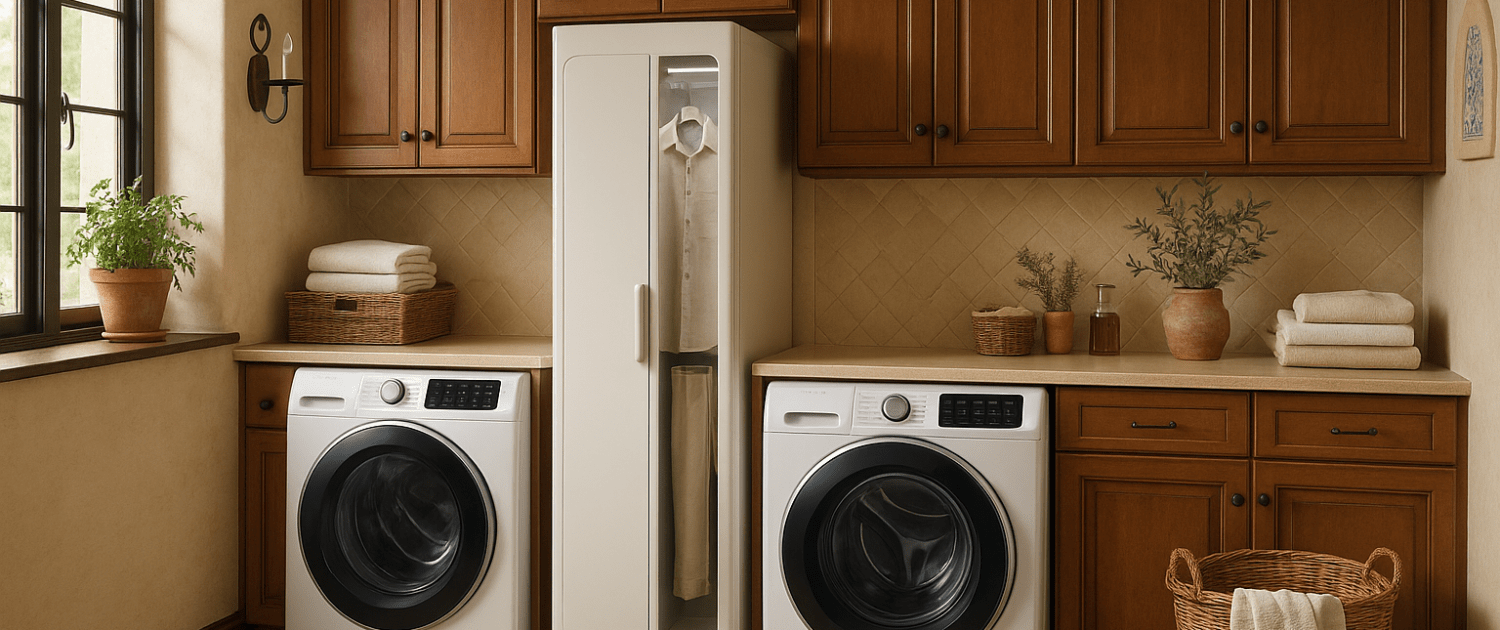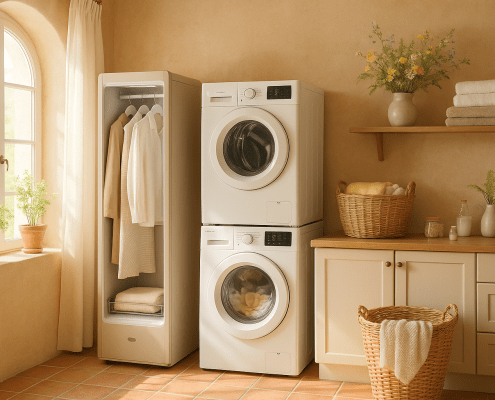Steam Closets or Dryers? How They Compare for Clothes Care
Steven E / Thursday September 4, 2025
If you’ve heard about steam closets and wondered how they stack up against the kind of dryer you’ve used your whole life, you’re in the right place. Both live in the laundry zone, both promise fresher clothes, and both can be lifesavers on a busy day, but they do very different jobs. We’ll break down how each one works, where they shine (and don’t), and how to choose the right setup for your home.
The One-Minute Answer
Traditional dryer:
Takes wet laundry from your washer and dries it with heated air and tumbling. Most households run it several times a week. Main mission: remove moisture quickly and evenly.
Steam closet (a.k.a. clothing refresher, garment “care” cabinet):
A standalone cabinet that uses steam plus gentle airflow/hangers to de-wrinkle, deodorize, and refresh already clean clothes. It’s a “between washes” tool, not a washer, and typically not a primary dryer.
What They Actually Do (Mechanics 101)
Dryer basics:
- Heat source: electric resistance coils or gas burner (plus a fan).
- Air movement: pulls in room air, heats it, tumbles clothes, vents humid air out (vented models) or condenses it (ventless/heat-pump models).
- Sensors: modern units use moisture sensors to stop at the right time and avoid overdrying.
- Result: removes water from fabric fibers; may add a short steam burst (if equipped) to reduce wrinkles, but drying is the main event.
Steam closet basics:
- Steam generation: heats water to produce steam that relaxes fibers.
- Hanging system: garments hang vertically, so they don’t tumble. Gravity + steam = fewer creases.
- Air refresh: low, gentle airflow helps carry away odors and moisture.
- Add-ons: light sanitizing cycles, trouser crease presses, shoe drying racks, aroma sheets.
- Result: reduces wrinkles and smells, loosens light stains or pollen, and can sanitize to a degree. It does not take soaking-wet loads to fully dry like a dryer does.
When Each One Could Make Your Day Easier
Traditional dryer wins when:
- You just washed a full load of towels, jeans, or bedding.
- You need laundry done in one evening, not tomorrow.
- You want that warm, fluffy feel from tumbling.
- You’re drying durable fabrics without special care needs.
Steam closet wins when:
- Your shirt is clean but wrinkled from the closet or suitcase.
- Your blazer or dress isn’t dirty enough to wash, but it smells like last night’s dinner.
- You wear tailored pieces that you’d rather not tumble.
- You want to freshen “dry clean only” between professional cleanings.
- You’re sensitive to allergens and want a quick sanitize/refresh for items that contact your skin or face (scarves, outerwear, baby blankets, check care labels).
Where they overlap:
Some premium dryers include a true steam option that can relax wrinkles and reduce static, but because clothes are tumbling and there’s more heat, results won’t match a vertical, hanger-based steam session on structured garments. Conversely, some steam closets can lightly dry damp items (e.g., a rained-on coat), but they’re not designed to dry a full, wet load.
Fabric Care: Gentle vs. Rough-and-Ready
Tumbling + heat (dryers):
Great for cottons, towels, athleisure, socks, and sheets. Less great for delicate silks, suit jackets, embellished dresses, or garments with heavy interfacing (lapels) that can deform with heat and tumble.
Hanging + steam (steam closets):
Great for tailored wool, silk blends, synthetics that hate creasing, pleated skirts, and blazers. Steam relaxes fibers without friction. Gentle cycles can help revive knits that get “chair wrinkles.” But steam can also over-relax certain finishes (sharp pleats, special coatings), so follow fabric labels.
Energy Use and Operating Costs
Traditional dryer:
- Typically the highest energy draw in a laundry setup but fast. Gas models often cost less to run where gas rates are low.
- Every full laundry day runs the dryer multiple cycles, so energy adds up.
Steam closet:
- Uses heat for steaming, but cycles are short and targeted. It won’t replace your dryer for full loads, yet it can reduce trips to the dry cleaner and extend wear between washes. Over time, that can save money on cleaning and help garments last longer.
- If you frequently refresh one or two pieces daily (work attire), the kilowatt-hours used may be modest compared to running a whole dryer cycle just to de-wrinkle a single shirt.
Bottom line: A steam closet is not an energy sink like a dryer because it’s not handling full wet loads. But it’s also not a replacement for the dryer you already own.
Installation: Space, Power, and Venting
Dryer:
- Venting: most traditional dryers need a vent to the outdoors. Ventless (condensation or heat-pump) models don’t, which helps in apartments or interior closets.
- Power: electric dryers usually need a 240V outlet; gas dryers need a gas line plus 120V power.
- Space: allow room behind for vent hose and airflow. Stacking with a front-load washer saves square footage.
Steam closet:
- Venting: none required. They’re self-contained.
- Power: many plug into a standard 120V outlet (check your model’s specs).
- Water: some use refillable water tanks; others can connect to a cold-water line. All require a drain or tank for condensate.
- Footprint: think “single-door wardrobe.” Make sure the door can swing open fully in your space, and you have ceiling clearance for long garments.
Speed and Convenience
Dryers:
- Full loads in ~30–60+ minutes depending on fabric and model.
- “Wrinkle release” or “steam refresh” cycles can help if you forgot to unload, but they still tumble everything.
Steam closets:
- Typical refresh cycles: ~15–30 minutes for a couple garments.
- You hang what you need, tap start, and go, no sorting, no full drum needed.
- Bonus: some models can send an alert to your phone when the cycle ends so your blazer doesn’t “re-wrinkle” from sitting in humid air.
Smart Features and Quality-of-Life Perks
Dryer:
- App controls, cycle recommendations, load sensors, lint monitoring, and energy reports.
- Some can integrate with home assistants for “start cycle” voice commands.
Steam closet:
- Outfit scheduling (pick a finish time so your suit is fresh by 7 a.m.).
- Quiet cycles you can run late at night without rattling.
- Trouser press attachments that clean up creases while you shower.
- Gentle shoe drying racks, great for sneakers that shouldn’t tumble.
The Verdict
- Traditional dryer = essential for drying full loads quickly and consistently.
- Steam closet = specialty tool for garment care, freshness, and wrinkle removal between washes, especially for tailored or delicate pieces.
Where To Find Us
If you need any replacement parts for your appliances, you can enter your model number at AppliancePartsPros.com to locate and order them quickly. Most orders arrive in just two business days, and we have tons of great information in our repair help section and YouTube videos to help you troubleshoot.
Stay connected with the latest DIY tips, tutorial videos, and repair guides by following us on Facebook, Instagram, and Twitter. We love hearing about your repair stories and successes. If you need more help or want personalized guidance, feel free to contact or call us at 877-477-7278. We’re ready to help you take on your next project with confidence!
Since 1999, AppliancePartsPros.com has helped millions of people repair their broken appliances by providing high-quality original parts at well below retail prices, free support and troubleshooting, and award-winning customer service from an expert, friendly, US-based customer support team!
Looking for the right part? Enter your appliance model number below to find the exact match and get your appliance running like new again!
With nearly a decade of experience in providing top-notch customer service regarding appliance parts and repair, Steven enjoys sharing practical advice, troubleshooting tips, and interesting information to help readers stay informed.






Leave a Reply
Want to join the discussion?Feel free to contribute!